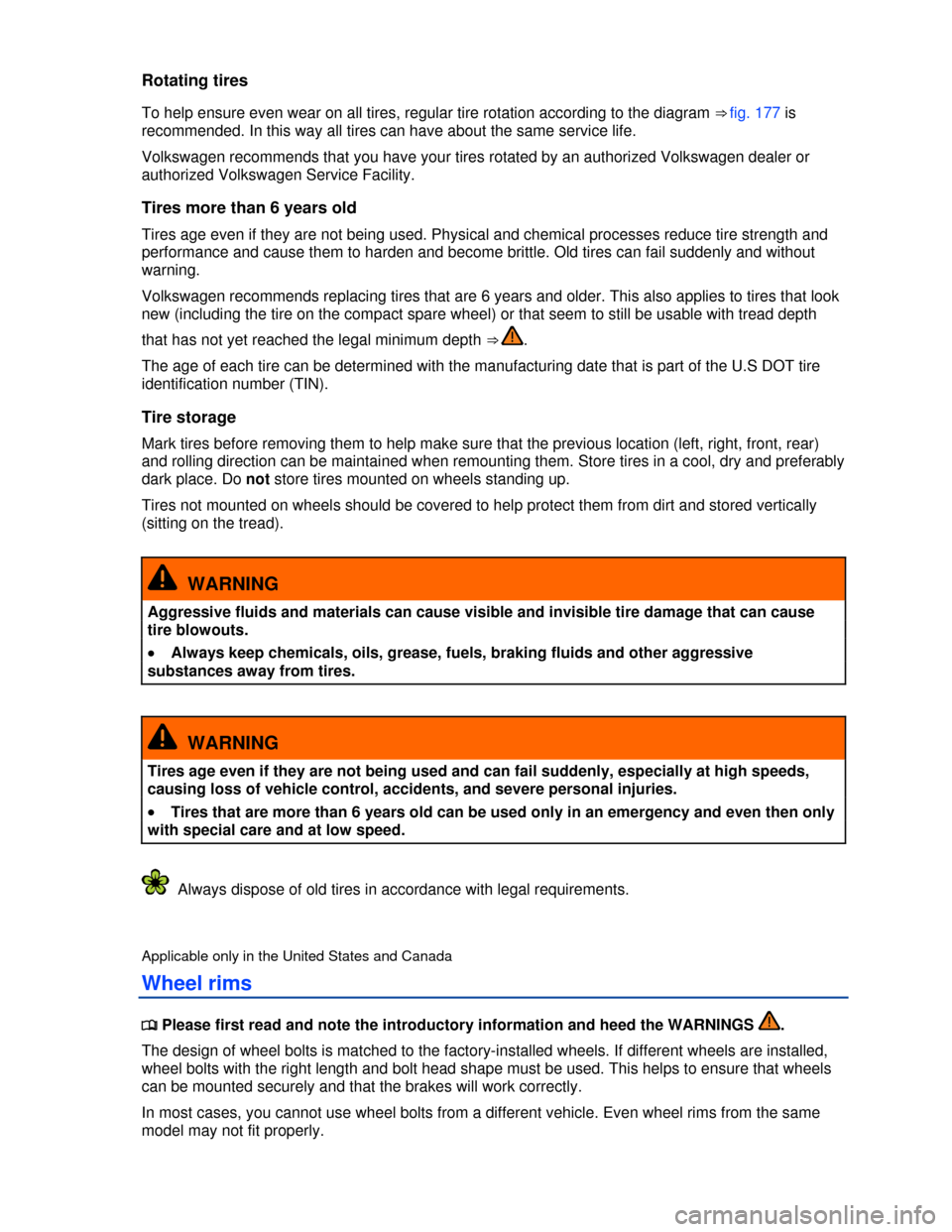2013 VOLKSWAGEN PASSAT fuel
[x] Cancel search: fuelPage 272 of 379

Engine oil quality is based not only on requirements for engines and exhaust treatment systems, but
also on fuel quality. Engine oil comes into contact with fuel and fuel residue in all internal combustion
engines, causing engine oil to age and its lubricating qualities to deteriorate.
Your engine was factory-filled with a high-quality, “synthetic” all-season engine oil that meets strict
Volkswagen oil quality standards and has a viscosity grade of SAE 5W-40. or SAE 5W-30. You can
use this oil for normal driving in all temperatures.
If you need to add oil between oil changes, use only a high quality oil that expressly complies with the
Volkswagen oil quality standard specified for your vehicle's engine:
Engines Engine oil specification
Gasoline engines VW 504 00, VW 503 00,
VW 502 00
NOTICE
�x If you need to add oil and there is none available that meets the Volkswagen oil quality
standard your engine requires, you may add a total of no more than 1/2 quart (0.5 liter) of a
high-quality “synthetic” oil that meets ACEA A3 specifications and has a viscosity grade of
SAE 5W-40 or SAE 5W-30.
�x Use only a high quality engine oil that expressly complies with the Volkswagen oil quality
standard specified for your vehicle's engine. Using any other engine oil can cause serious
damage that will not be covered by any Volkswagen Limited Warranty.
�x Do not mix any lubricants or other additives into the engine oil. Doing so can cause engine
damage! Damage caused by these kinds of additives are not covered by any Volkswagen
Limited Warranty.
Applicable only in the United States, Canada, and South Korea
Engine oil capacities
�
Page 293 of 379

Rotating tires
To help ensure even wear on all tires, regular tire rotation according to the diagram ⇒ fig. 176 is
recommended. In this way all tires can have about the same service life.
Volkswagen recommends that you have your tires rotated by an authorized Volkswagen dealer or
authorized Volkswagen Service Facility.
Tires more than 6 years old
Tires age even if they are not being used. Physical and chemical processes reduce tire strength and
performance and cause them to harden and become brittle. Old tires can fail suddenly and without
warning.
Volkswagen recommends replacing tires that are 6 years and older. This also applies to tires that look
new (including the tire on the compact spare wheel) or that seem to still be usable with tread depth
that has not yet reached the legal minimum depth ⇒ .
The age of each tire can be determined with the manufacturing date that is part of the U.S DOT tire
identification number (TIN).
Tire storage
Mark tires before removing them to help make sure that the previous location (left, right, front, rear)
and rolling direction can be maintained when remounting them. Store tires in a cool, dry and preferably
dark place. Do not store tires mounted on wheels standing up.
Tires not mounted on wheels should be covered to help protect them from dirt and stored vertically
(sitting on the tread).
WARNING
Aggressive fluids and materials can cause visible and invisible tire damage that can cause
tire blowouts.
�x Always keep chemicals, oils, grease, fuels, braking fluids and other aggressive
substances away from tires.
WARNING
Tires age even if they are not being used and can fail suddenly, especially at high speeds,
causing loss of vehicle control, accidents, and severe personal injuries.
�x Tires that are more than 6 years old can be used only in an emergency and even then only
with special care and at low speed.
Always dispose of old tires in accordance with legal requirements.
Page 295 of 379

Rotating tires
To help ensure even wear on all tires, regular tire rotation according to the diagram ⇒ fig. 177 is
recommended. In this way all tires can have about the same service life.
Volkswagen recommends that you have your tires rotated by an authorized Volkswagen dealer or
authorized Volkswagen Service Facility.
Tires more than 6 years old
Tires age even if they are not being used. Physical and chemical processes reduce tire strength and
performance and cause them to harden and become brittle. Old tires can fail suddenly and without
warning.
Volkswagen recommends replacing tires that are 6 years and older. This also applies to tires that look
new (including the tire on the compact spare wheel) or that seem to still be usable with tread depth
that has not yet reached the legal minimum depth ⇒ .
The age of each tire can be determined with the manufacturing date that is part of the U.S DOT tire
identification number (TIN).
Tire storage
Mark tires before removing them to help make sure that the previous location (left, right, front, rear)
and rolling direction can be maintained when remounting them. Store tires in a cool, dry and preferably
dark place. Do not store tires mounted on wheels standing up.
Tires not mounted on wheels should be covered to help protect them from dirt and stored vertically
(sitting on the tread).
WARNING
Aggressive fluids and materials can cause visible and invisible tire damage that can cause
tire blowouts.
�x Always keep chemicals, oils, grease, fuels, braking fluids and other aggressive
substances away from tires.
WARNING
Tires age even if they are not being used and can fail suddenly, especially at high speeds,
causing loss of vehicle control, accidents, and severe personal injuries.
�x Tires that are more than 6 years old can be used only in an emergency and even then only
with special care and at low speed.
Always dispose of old tires in accordance with legal requirements.
Applicable only in the United States and Canada
Wheel rims
�
Page 313 of 379

Z over 149 mph (240 km/h)
W up to 168 mph (270 km/h)
Y up to 186 mph (300 km/h)
Some tire manufacturers label tires with a maximum permissible road speed above 149 mph
(240 km/h) with the letter combination “ZR.”
WARNING
Using incorrect or unmatched tires and/or wheels or improper tire and wheel combinations
can lead to loss of control, collision and serious personal injury.
�x Always use tires, wheels and wheel bolts that meet the specifications of the original
factory-installed tires or other combinations that have been specifically approved by the
vehicle manufacturer.
�x All 4 wheels must be fitted with radial tires of the same type, the same size (tread
circumference), and the same tread pattern. Driving with different tires reduces vehicle
handling and can lead to a loss of control.
�x Never drive faster than the maximum speed for which the tires installed on your vehicle
are rated because tires that are driven faster than their rated speed can fail suddenly.
�x Overloading tires can cause heat build-up, sudden tire failure, including a blowout and
sudden deflation and loss of control.
�x Temperature grades apply to tires that are properly inflated and not over- or underinflated.
Applicable only in Korea
Tire efficiency label
Fig. 186 Fuel efficiency labels.
�
Page 315 of 379

Install summer tires promptly in the spring. Summer tires offer better handling characteristics for
temperatures above +45 °F (+7 °C). They are quieter, do not wear as quickly, and reduce fuel
consumption.
The Tire Pressure Monitoring System must be recalibrated using the SET button whenever you
remove and remount or change any wheel or tire on the vehicle, even if the reinstalled or replacement
wheels and tires are identical to those that were removed and even if the tire pressure does not
change.
If necessary, ask your authorized Volkswagen dealer or authorized Volkswagen Service Facility
about permissible winter tire dimensions.
Applicable only in Mexico, the AGCC, and South Korea
Winter tires
�
Page 316 of 379

WARNING
Driving faster than the maximum speed for which the winter tires on your vehicle were
designed can cause sudden tire failure including a blowout and sudden deflation, loss of
control, crashes and serious personal injuries.
�x Winter tires have a maximum speed rating that may be lower than your vehicle's maximum
speed.
�x Never drive faster than the maximum speed for which the winter tires installed on your
vehicle are rated because tires that are driven faster than their rated speed can fail suddenly.
�x Never exceed the maximum load rating for the winter tires installed on your vehicle.
Install summer tires promptly in the spring. Summer tires offer better handling characteristics for
temperatures above +45 °F (+7 °C). They are quieter, do not wear as quickly, and reduce fuel
consumption.
The Tire Pressure Monitoring System must be recalibrated using the SET button whenever you
remove and remount or change any wheel or tire on the vehicle, even if the reinstalled or replacement
wheels and tires are identical to those that were removed and even if the tire pressure does not
change.
If necessary, ask your authorized Volkswagen dealer or authorized Volkswagen Service Facility
about permissible winter tire dimensions.
Applicable only in the United States and Canada
Snow chains
�
Page 319 of 379

Cracking
Any parting within the tread, sidewall, or inner liner of the tire extending to cord material.
Cold tire inflation pressure
The tire pressure recommended by the vehicle manufacturer for a tire of a specified size that has not
been driven for more than a couple of miles (kilometers) at low speeds in the 3 hour period before the
tire pressure is measured or adjusted.
Curb weight
The weight of a motor vehicle with standard equipment including the maximum capacity of fuel, oil,
and coolant, air conditioner, and additional weight of optional equipment.
Extra load tire
A tire designed to operate at higher loads and at higher inflation pressures than the corresponding
standard tire.
Gross Axle Weight Rating (GAWR)
The load-carrying capacity of a single axle system, measured where the tire contacts the ground.
Gross Vehicle Weight Rating (GVWR)
The maximum loaded weight of the vehicle.
Groove
The space between 2 adjacent tread ribs.
Load rating (code)
The maximum load that a tire is rated to carry for a given inflation pressure. You may not find this
information on all tires because it is not required by law.
Maximum load rating
The load rating for a tire at the maximum permissible inflation pressure for that tire.
Maximum loaded vehicle weight
The total of:
�x Curb weight
�x Accessory weight.
�x Vehicle capacity weight.
�x Production options weight.
Maximum (permissible) inflation pressure
The maximum cold inflation pressure to which a tire may be inflated. Also called “maximum inflation
pressure.”
Normal occupant weight
Means 150 lbs (68 kilograms) times the number of occupants seated in the vehicle up to the total
seating capacity of your vehicle.
Occupant distribution
The placement of passengers in a vehicle.
Outer diameter
The diameter of a new, properly inflated tire.
Page 323 of 379

Cord separation
The parting of cords from adjacent rubber compounds.
Cracking
Any parting within the tread, sidewall, or inner liner of the tire extending to cord material.
Cold tire inflation pressure
The tire pressure recommended by the vehicle manufacturer for a tire of a specified size that has not
been driven for more than a couple of miles (kilometers) at low speeds in the 3 hour period before the
tire pressure is measured or adjusted.
Curb weight
The weight of a motor vehicle with standard equipment including the maximum capacity of fuel, oil,
and coolant, air conditioner, and additional weight of optional equipment.
Extra load tire
A tire designed to operate at higher loads and at higher inflation pressures than the corresponding
standard tire.
Gross Axle Weight Rating (GAWR)
The load-carrying capacity of a single axle system, measured where the tire contacts the ground.
Gross Vehicle Weight Rating (GVWR)
The maximum loaded weight of the vehicle.
Groove
The space between 2 adjacent tread ribs.
Load rating (code)
The maximum load that a tire is rated to carry for a given inflation pressure. You may not find this
information on all tires because it is not required by law.
Maximum load rating
The load rating for a tire at the maximum permissible inflation pressure for that tire.
Maximum loaded vehicle weight
The total of:
�x Curb weight
�x Accessory weight.
�x Vehicle capacity weight.
�x Production options weight.
Maximum (permissible) inflation pressure
The maximum cold inflation pressure to which a tire may be inflated. Also called “maximum inflation
pressure.”
Normal occupant weight
Means 150 lbs (68 kilograms) times the number of occupants seated in the vehicle up to the total
seating capacity of your vehicle.
Occupant distribution
The placement of passengers in a vehicle.